Header image from National Park Service.gov, Rocky Mountain National Park, Colorado
Colorado joined the union on August 1, 1876 as the 38th State.
Bird:Lark Bunting
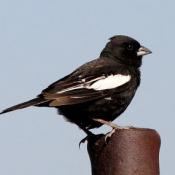 . State bird of Colorado
. State bird of Colorado
The lark bunting is a medium-sized American sparrow native to central and western North America.
Lark Buntings have interesting domestic arrangements. Pairs often nest close to one another in a loose “colony,” much as Dickcissels do. Most are monogamous, but some males breed with multiple partners (a mating system known as polygyny). In other areas, when males outnumber females, unmated males seem to serve as “nest helpers,” bringing food to young at the nest.
Sexual selection in lark buntings is particularly interesting, as female mate choice is radically different from year to year. In different years, females show preference based on males’ black coloring, size of wing patch, size of beak, as well as other characteristics
Flower: Columbine
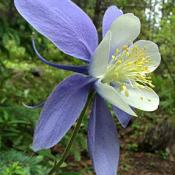
Columbine was named for the Latin word columba, which means dove. Native Americans used the seeds to make an infusion to treat headaches. The flowers of various species of columbine were consumed in moderation by Native Americans as a condiment with other fresh greens, and are reported to be very sweet, and safe if consumed in small quantities. The plant’s seeds and roots are highly poisonous however, and contain cardiogenic toxins which cause both severe gastroenteritis and heart palpitations if consumed as food.
Tree: Colorado Blue Spruce
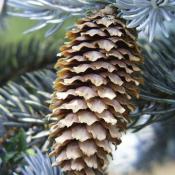
A coniferous evergreen tree. Blue spruce trees are noticeably blue-hued, because of the waxy, powdery layer that is found on the needles. The blue spruce is also the official state tree of Utah.
The Navajo and Keres Native Americans used this tree as a traditional medicinal plant and a ceremonial item, and twigs are given as gifts to bring good fortune. In traditional medicine, an infusion of the needles is used to treat colds and settle the stomach. This liquid is also used externally for rheumatic pains. Early people used their wood for building
State Quarter
From theus50.com
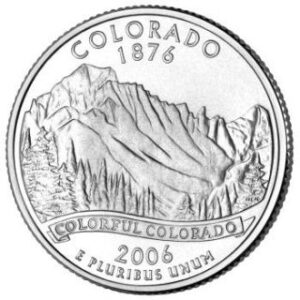
The Colorado quarter depicts a sweeping view of the state’s rugged Rocky Mountains with evergreen trees and a banner carrying the inscription “Colorful Colorado.” The coin also bears the inscriptions “Colorado” and “1876”.
Colorado’s Rocky Mountains are home to some of the Nation’s most majestic natural wonders. Among these, rising approximately 10,000 feet from the valley floor in Northwest Colorado, Grand Mesa is the largest flat-top mountain in the world, and is home to more than 200 lakes and many miles of scenic hiking trails.
Colorado was admitted into the Union on August 1, 1876, becoming our Nation’s 38th state. With statehood gained less than one month after the 100th anniversary of the signing of the Declaration of Independence, Colorado is nicknamed the “Centennial State”.
Capital: Denver
Nickname: Centennial State
Motto: Nothing Without Providence
Colorado Facts and Trivia
The first European to visit Colorado was Spanish explorer Francisco de Coronado in 1541. Coronado traveled through the region searching for gold. He didn’t find gold and soon left the area. Many years later in 1682, French explorer Robert de La Salle entered eastern Colorado. He claimed the land for France and it became part of France’s Louisiana territory.
In 1803, the United States bought eastern Colorado from France as part of the Louisiana Purchase. American explorer Zebulon Pike traveled through Colorado following the Arkansas River in 1806. He mapped out the region including an extremely high mountain which later became known as Pikes Peak. While in Colorado, Pike and his men were arrested by the Spanish and taken as prisoners to Mexico. They were released in July of 1807.
In the early 1800s, settlers began moving into Colorado. They were mostly fur traders and trappers. In 1821, the Santa Fe Trail opened up between Missouri and New Mexico. It passed through southeast Colorado bringing more people to the region.
After the Mexican-American war ended in 1848, the United States gained control of western Colorado. Ten years later, in 1858, gold was discovered near Pikes Peak. Many thousands of people rushed to Colorado in hopes of striking it rich. Their motto was “Pikes Peak or Bust.” As a result of Colorado’s growth, the Colorado Territory was created by the U.S. government in 1861. Colorado continued to grow after the Denver Pacific Railway reached Denver in 1870.
On November 7, 1876, Colorado was admitted to the United States as the 38th state.
The Colorado Rockies are part of the North American Cordillera, which stretches 3,000 miles from Alaska, through western Canada and the United States, into northern Mexico. The centerpieces of this dramatic uplift are the peaks over 14,000 feet, or “Fourteeners”, as they are affectionately referred to by climbers. There are 52 Fourteeners in Colorado.
“Beulah red” is the name of the red marble that gives the Colorado State Capitol its distinctive splendor. Cutting, polishing, and installing the marble in the Capitol took six years, from 1894 to 1900. All of the “Beulah red” marble in the world went into the Capitol. It cannot be replaced, at any price.
The United States Air Force Academy is located in Colorado Springs.
The Durango & Silverton Narrow Gauge Railroad continues to provide year round train service operating a historical train with rolling stock indigenous to the line. The line was constructed primarily to haul mine ores, both gold and silver, from the San Juan Mountains.
The United States federal government owns more than 1/3 of the land in Colorado.
Katherine Lee Bates wrote “America the Beautiful” after being inspired by the view from Pikes Peak.
Colorado’s southwest corner borders Arizona, New Mexico and Utah the only place in America where the corners of four states meet.
Colorado’s first and oldest military post, Fort Garland was established in 1858 and commanded by the legendary frontiersman Kit Carson.
John Henry “Doc” Holliday’s brief and tumultuous existence led him to Glenwood Springs where he succumbed to tuberculosis and died at the Hotel Glenwood on November 8, 1887.
Colorado is considered a swing state in both state and federal elections. Coloradans have elected 17 Democrats and 12 Republicans to the governorship in the last 100 years. In presidential politics, Colorado was considered a reliably Republican state during the post-World War II era, only voting for the Democratic candidate in 1948, 1964, and 1992. However, it became a competitive swing state by the turn of the century, and voted consecutively for Democrat Barack Obama in 2008 and 2012, as well as Democrat Hillary Clinton in 2016.
Strange Laws
In Colorado, it is illegal to ride a horse while under the influence. It’s also illegal to fish from the back of a horse.
In Colorado, one may not “mutilate” a rock or range stone.
Car dealers may not show cars on a Sunday.
It is unlawful to lend your vacuum cleaner to your next-door neighbor (Denver)
Couches may not be placed on outside porches (Boulder)
People:
 Tim Allen, actor
Tim Allen, actor- M. Scott Carpenter, astronaut
- Lon Chaney, actor
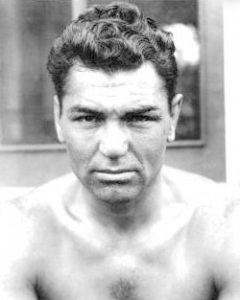 William Harrison (Jack) Dempsey, boxer
William Harrison (Jack) Dempsey, boxer- Ralph Edwards, entertainer
- Douglas Fairbanks, actor
 John Kerry, politician
John Kerry, politician- Ted Mack, TV host
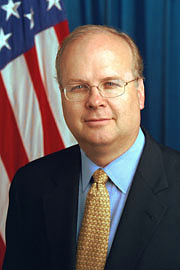 Karl Rove, political consultant
Karl Rove, political consultant- Jan-Michael Vincent, actor
 Scott Walker, politician
Scott Walker, politician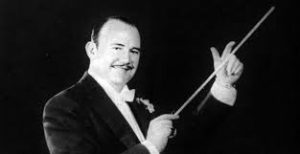 Paul Whiteman, conductor
Paul Whiteman, conductor
Credits:
See only in your state.com
See ducksters.com
See gazette.com
See 50 states.com
